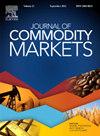原油、绿色金融和有色金属市场的互联性和时频溢出效应:一个高矩分析
IF 4.5
4区 经济学
Q1 BUSINESS, FINANCE
引用次数: 0
摘要
本文在时频域研究了原油、绿色金融和有色金属市场中波动率、偏度和峰度等高矩的溢出效应。我们采用Diebold和Yilmaz(2012)以及Baruník和Křehlík(2018)的溢出方法,以及GARCHSK高矩模型来分析这些市场之间的相互关联性。我们的研究揭示了几个关键发现:首先,考虑高阶矩时,溢出效应减弱,显著溢出集中在较低频率。其次,溢出效应具有时变特征,在动荡时期溢出效应强度增大。第三,个体市场的净溢出作用因频率和矩型而异,表明溢出效应的不对称性。例如,铅和镍作为主要的净发射器,除了短期和中期的波动性溢出,而ESG市场作为净发射器,不包括较低频率的偏度溢出。最后,构建绿色金融资产或石油资产与有色金属资产并存的投资组合,可以有效降低投资组合风险。这项工作为旨在建立平衡投资组合的投资者和设计有效风险管理策略的监管机构提供了宝贵的见解。本文章由计算机程序翻译,如有差异,请以英文原文为准。
Interconnectedness and time-frequency spillover effects in crude oil, green finance and non-ferrous metal Markets: A high moments analysis
This paper investigates the spillover effects of high moments, including volatility, skewness, and kurtosis, in the crude oil, green finance and non-ferrous metal markets in the time-frequency domain. We employ spillover methods by Diebold and Yilmaz (2012) and Baruník and Křehlík (2018), together with the GARCHSK higher-moment model, to analyze the interconnectedness among these markets. Our study reveals several key findings: Firstly, spillover effects diminish as higher-order moments are considered, with significant spillovers concentrated at lower frequencies. Secondly, spillovers exhibit time-varying characteristics, with heightened intensity during turbulent period. Thirdly, the net spillover roles of individual markets vary by frequency and moment type, indicating asymmetry in spillover effects. For example, lead and nickel act as primary net transmitters, except for volatility spillovers over short- and medium-term periods, while ESG market serves as a net transmitter, excluding skewness spillovers at lower frequencies. Lastly, constructing portfolios that include green financial assets or oil assets alongside non-ferrous metal assets can effectively reduce portfolio risk. This work offers valuable insights for investors aiming to build balanced portfolios and for regulators designing effective risk management strategies.
求助全文
通过发布文献求助,成功后即可免费获取论文全文。
去求助
来源期刊

Journal of Commodity Markets
Multiple-
CiteScore
5.70
自引率
2.40%
发文量
53
期刊介绍:
The purpose of the journal is also to stimulate international dialog among academics, industry participants, traders, investors, and policymakers with mutual interests in commodity markets. The mandate for the journal is to present ongoing work within commodity economics and finance. Topics can be related to financialization of commodity markets; pricing, hedging, and risk analysis of commodity derivatives; risk premia in commodity markets; real option analysis for commodity project investment and production; portfolio allocation including commodities; forecasting in commodity markets; corporate finance for commodity-exposed corporations; econometric/statistical analysis of commodity markets; organization of commodity markets; regulation of commodity markets; local and global commodity trading; and commodity supply chains. Commodity markets in this context are energy markets (including renewables), metal markets, mineral markets, agricultural markets, livestock and fish markets, markets for weather derivatives, emission markets, shipping markets, water, and related markets. This interdisciplinary and trans-disciplinary journal will cover all commodity markets and is thus relevant for a broad audience. Commodity markets are not only of academic interest but also highly relevant for many practitioners, including asset managers, industrial managers, investment bankers, risk managers, and also policymakers in governments, central banks, and supranational institutions.
 求助内容:
求助内容: 应助结果提醒方式:
应助结果提醒方式:


